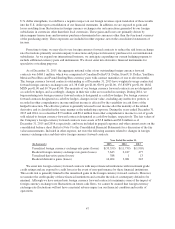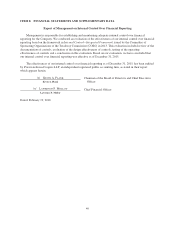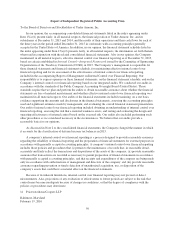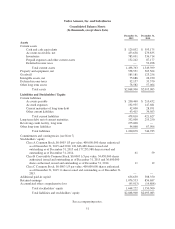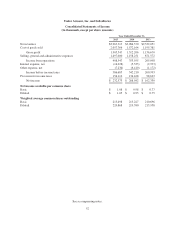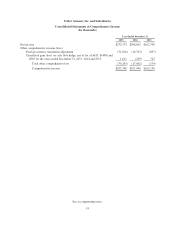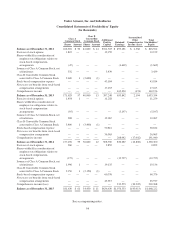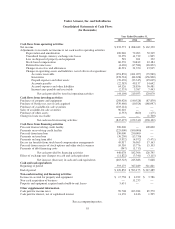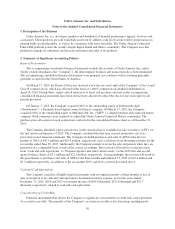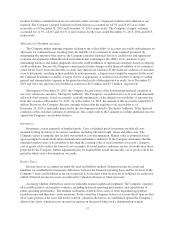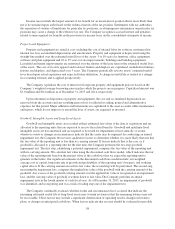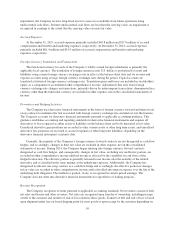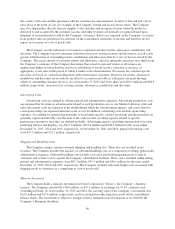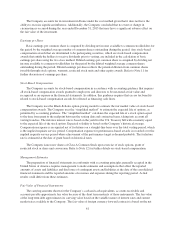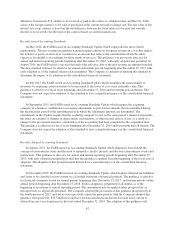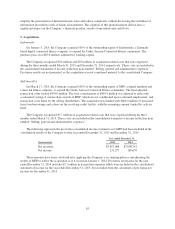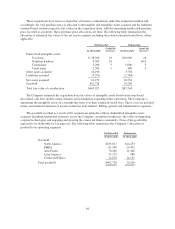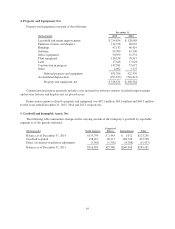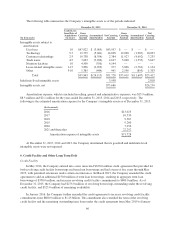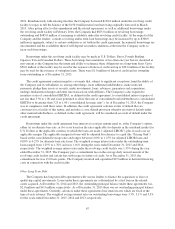Under Armour 2015 Annual Report Download - page 65
Download and view the complete annual report
Please find page 65 of the 2015 Under Armour annual report below. You can navigate through the pages in the report by either clicking on the pages listed below, or by using the keyword search tool below to find specific information within the annual report.retailers. Credit is extended based on an evaluation of the customer’s financial condition and collateral is not
required. The Company’s largest customer in North America accounted for 18.7% and 23.4% of accounts
receivable as of December 31, 2015 and December 31, 2014, respectively. The Company’s largest customer
accounted for 11.5%, 14.4% and 16.6% of net revenues for the years ended December 31, 2015, 2014 and 2013,
respectively.
Allowance for Doubtful Accounts
The Company makes ongoing estimates relating to the collectability of accounts receivable and maintains an
allowance for estimated losses resulting from the inability of its customers to make required payments. In
determining the amount of the reserve, the Company considers historical levels of credit losses and significant
economic developments within the retail environment that could impact the ability of its customers to pay
outstanding balances and makes judgments about the creditworthiness of significant customers based on ongoing
credit evaluations. Because the Company cannot predict future changes in the financial stability of its customers,
actual future losses from uncollectible accounts may differ from estimates. If the financial condition of customers
were to deteriorate, resulting in their inability to make payments, a larger reserve might be required. In the event
the Company determines a smaller or larger reserve is appropriate, it would record a benefit or charge to selling,
general and administrative expense in the period in which such a determination was made. As of December 31,
2015 and 2014, the allowance for doubtful accounts was $5.9 million and $3.7 million, respectively.
Subsequent to December 31, 2015, the Company became aware of the deteriorating financial condition of
one of its wholesale customers, The Sports Authority. The Company’s recorded reserve as of year-end materially
reflects its best estimate, based on currently available information, of the ultimate recoverability of amounts due
from this customer at December 31, 2015. As of December 31, 2015, the amount of this receivable totaled $32.5
million. However, the Company does not currently believe that the exposure to its receivables as of
December 31, 2015 is materially impacted by the developments related to The Sports Authority. If the financial
condition of this customer continues to deteriorate, this could result in the Company recording additional reserves
against the Company’s receivables balance.
Inventories
Inventories consist primarily of finished goods. Costs of finished goods inventories include all costs
incurred to bring inventory to its current condition, including inbound freight, duties and other costs. The
Company values it using the first-in, first-out method of cost determination. Market value is estimated based
upon assumptions made about future demand and retail market conditions. If the Company determines that the
estimated market value of its inventory is less than the carrying value of such inventory, it records a charge to
cost of goods sold to reflect the lower of cost or market. If actual market conditions are less favorable than those
projected by the Company, further adjustments may be required that would increase the cost of goods sold in the
period in which such a determination was made.
Income Taxes
Income taxes are accounted for under the asset and liability method. Deferred income tax assets and
liabilities are established for temporary differences between the financial reporting basis and the tax basis of the
Company’s assets and liabilities at tax rates expected to be in effect when such assets or liabilities are realized or
settled. Deferred income tax assets are reduced by valuation allowances when necessary.
Assessing whether deferred tax assets are realizable requires significant judgment. The Company considers
all available positive and negative evidence, including historical operating performance and expectations of
future operating performance. The ultimate realization of deferred tax assets is often dependent upon future
taxable income and therefore can be uncertain. To the extent the Company believes it is more likely than not that
all or some portion of the asset will not be realized, valuation allowances are established against the Company’s
deferred tax assets, which increase income tax expense in the period when such a determination is made.
57


